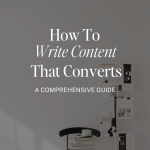Are you looking to improve your content writing? Perhaps you want to write more compelling blog posts that will convert your readers into customers. Or perhaps you need to create more powerful email marketing content that will drive results or increase your email sign-ups. If so, you’re in the right place. In this comprehensive guide, we’ll show you how to write content that converts. In today’s post, we’ll cover everything from understanding your audience to creating headlines that grab attention and deliver results.
So if you’re ready to learn how to write content that converts, let’s get started!

To create content that converts, it’s important to understand your audience, their pain points and what they want to read your blog posts. Once you’ve established this, you can create content that is both informative and easy for your readers to understand. Always keep in mind that your goal is to get the reader to take action, whether that’s subscribing to a newsletter or sharing your content with their friends. Let’s deep dive into this further…
Why Is Content Vital For Conversions?
Content is vital for driving conversions. By providing valuable, relevant, and targeted content, you can guide your audience and customers through a buyer’s journey, ultimately leading them to conversion if you’re looking at gaining sales.
Creating content that converts is typically well-written, informative, and persuasive. It speaks to the needs and wants of your target audience, and provides them with a clear path to conversion.
If you’re looking to write content that converts, be sure to keep these things in mind. With a little effort, you can produce content that helps you close more deals and boost your bottom line.
You want to remember to keep these key things in mind:
- Write to your audience, and address their pain points and struggles.
- Keep it short, sweet, and to the point.
- Use images, videos, and infographics to break up your text and add visual interest.
- Make sure to test!
How to Create Content that Converts Visitors
To create content that converts, you need to start with your target audience in mind. What are their needs and struggles? What content do they search for? Once you have a good understanding of who your target audience is, you can start creating headlines that speak to them. Your headline should be attention-grabbing and entice them to want to read more. The body of your content piece should be well-written, informative and addresses the needs of your target audience. Be sure to include calls to action throughout your content to encourage conversions. And finally, don’t forget about SEO! Make sure your content is optimized for search engines so that it can be easily found by your target audience.
Related post: 6 Ways to Enhance Your Blog Posts SEO Ranking
Content marketing is a great way to reach your target audience and convert them into customers or clients. But it’s not enough to just create any old piece of content. It needs to be great content that speaks to the needs of your target audience. So take some time to plan out your content strategy and create content that will help you reach your goals.
Setting Up Achievable Content Marketing Goals
Content Marketing:
The first step is to understand what content marketing is and what it can do for your business. Content marketing is the creation and sharing of online material (such as videos, blogs, and social media posts) that does not explicitly promote a brand but is intended to stimulate interest in its products or services.
Content that Converts:
Next, you need to create content that actually converts. This means creating content that speaks to your target audience’s pain points and addresses their needs. It should also be SEO-friendly and easy to consume. We all know how important SEO is to ensure your content ranks on Google.
Brand Awareness:
Another important goal of content marketing is to increase brand awareness. This means creating content that showcases your brand in a positive light and helps to build trust with potential customers.
Bottom of the Sales Funnel:
Finally, you need to make sure that your content reaches the right people at the right time. This means creating content that is targeted at the bottom of the funnel, where people are more likely to be ready to convert. This can be determined by looking at your website or content’s analytics. It’s important to ensure your website is linked to Google Analytics so you can easily track what content your readers found useful.
5 Ways to Writing Content That Converts
If you’re feeling stuck and not sure where to get started here are 5 ways to write your content that converts.
1. Create Enticing Headlines
Your headline is the first, and maybe only, opportunity to convince someone to click and read your entire blog post. So it’s important to make it interesting and compelling. A title that will grab their attention right away!
There are a few key elements to writing a good headline:
- Keep it short and to the point
- Use strong verbs to convey action
- Use numbers or lists to add structure
- Use keywords to target your audience
Here are a few examples of headlines that would work well for a blog post on how to write content that converts:
- 3 Steps to Writing Content that Converts Like Crazy
- How to Write Content that Converts: The Ultimate Guide
- 10 Tips for Writing Content that Converts
- How to Write Content that Converts: A Comprehensive Guide
- The Ultimate Guide to Writing Content that Converts
How-to posts are always a winner! so when in doubt create a tutorial to educate your audience.
2. Keep Your Content Simple & Easy to Understand
If you want your blog content to convert, focus on creating that is simple and easy to understand. Use clear, easy-to-read and concise language that your readers will be able to understand and appreciate. Don’t try to sound too smart or use big words just for the sake of it – it’ll only make your content harder to digest and, as a result, less likely to convert. Instead, focus on using language that’s easy to understand and terms that your target audience is likely to be familiar with.
However, avoid using industry jargon as it can create confusion (we all know how annoying reading terms we don’t understand) and turn off your readers. Instead, focus on using language that’s easy to understand and terms that your target audience is likely to be familiar with. Doing so will make your content more relatable and, as a result, more likely to convert.
3. Focus on the Right Keywords
If you want content that’s found on the worldwide internet. One of the most important aspects of writing content that increase your conversion is to focus on the right keywords. Identify the keywords that potential customers are searching for and make sure to integrate them into your content. But don’t stuff your content with keywords – this will only turn off potential customers.
Keep in mind that you’re instead, using them sparingly and focusing on delivering quality, informative content. Your readers will thank you for it, and you’ll be more likely to convert them into paying customers. Use tools like Semrush or Ubersuggest to do your keyword research to know exactly what keywords to use to help with your content ranking.
Related Post: The Best Google SEO Tools Every Blogger Should Use
4. Use Content Upgrades to Increase Conversions
If you want to write content that converts visitors, then you need to use content upgrades. A content upgrade is a piece of content that is designed to complement an existing piece of content and make it more valuable to the reader. By offering a content upgrade, you can increase the chances that a reader will convert, by giving them something that is directly relevant to the article they are reading. An example of a content upgrade is creating useful free content like an ebook that ties into the topic of the blog post or to a course you’re selling.
5. Don’t Forget to Add a Call-To-Action
The guide wouldn’t be complete without a reminder to include a call-to-action (CTA) in your content. A CTA is a statement or question that encourages your readers to take a specific action, such as signing up for a newsletter, downloading a guide, or making a purchase.
Without a CTA, your content may be informative and interesting, but it won’t necessarily prompt your readers to take action. Including ctas in your content will help ensure that your content is not only informative and interesting but also converts readers into leads or customers. You want to make sure that your CTA is clear and direct, and that it is placed prominently on the page.
Including a CTA (call-to-action) is an important element of writing content that converts. A CTA can be in the form of a button, link, or even just a statement that encourages the reader to take a specific action, such as signing up for a newsletter or downloading a white paper.
In conclusion, building a content-rich website is a great way to add interesting content to your website. Content-rich websites grow website traffic, which directly increases your potential sales. However, quality content isn’t easy to create. It takes a lot of time and effort, which you need to put in consistently. You need to convince readers to stay on your website. And, you need to persuade them to buy your products or services.
PIN FOR LATER ↓


WANNA READ MORE?






















0 Comments